[ad_1]
Eighteen months ago, Noland Arbaugh became the first person to implant a brain chip by a company owned by Elon Musk, Neuralink, and his life has taken a fantastic turn. Arbaugh lost his ability to move and feel below his shoulders in a swimming accident in 2016, but he says the technology has given him a taste of independence and purpose that was long lost.
Starting with a Mario Kart game to taking college courses and even planning a business, the story of Arbaugh, as reported by Fortune, demonstrates how brain-computer interfaces can transform the future of human potential.
🧠 Actual Neuralink 18-Month Update 🦾
Let’s just say the past 18 months haven’t exactly been boring.
One moment I was booting up Eve. Next thing I know, we’re a year and a half deep, and she’s got opinions.
July 28th marked 18 months since Eve and I were joined in holy…
— Noland Arbaugh (@ModdedQuad) August 7, 2025
Life With the Neuralink Brain Chip
In 2024, Arbaugh received a Neuralink implant in a procedure that involved a surgical robot drilling a coin-sized hole in his skull and then inserting more than 1,000 electrodes into his brain. Such electrodes interpret electronic signals and translate them into digital commands, allowing him to operate devices with no bodily motions.
Now he uses the brain-computer interface (BCI) close to 10 hours per day to study, read, play games, and complete most of his everyday jobs, such as switching his television and air purifier on or off. “I feel like I have potential again,” he said, describing how the device has restored both independence and purpose.
Challenges and Optimism Ahead
The path has not been perfect. Soon after the surgery, parts of the implant threads began to back out and resulting in Arbaugh losing control of the implant. Rather than talking openly about the setback, he had Neuralink engineers troubleshoot behind the scenes, and they later regained full functionality.
Arbaugh says it was an easy decision to volunteer as the first clinical trial patient, even though the risks were high. “Even if it didn’t work, I knew it would help someone down the road,” he said. Today, he laughs about becoming a cyborg, but says that he is a simple, ordinary man, now with an exceptional ability to use technology with his mind.
[ad_2]



